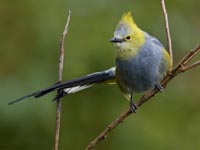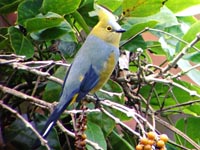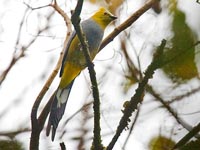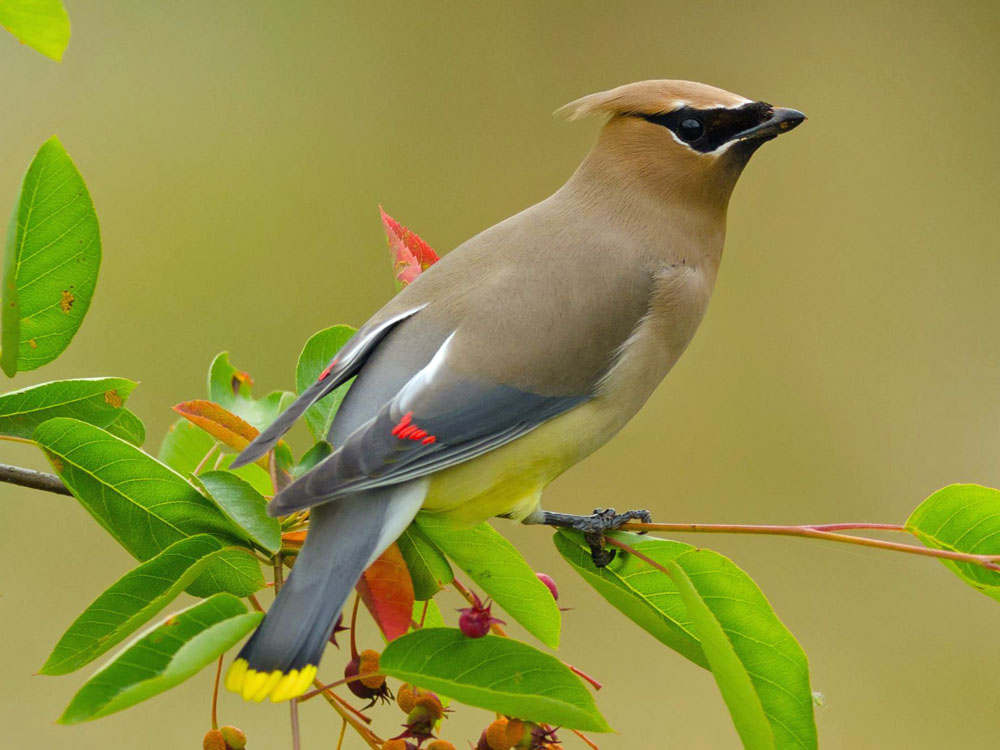The Bombycillidae family has only 1 genus Bombycilla, the waxwings. All three species have mainly grey-brown plumage, a black line through the eye and black under the chin, a square-ended tail with a red or yellow tip, and a pointed crest. Their plumage is smooth looking, not a feather out of place. When available they eat fruit, but waxwings will also eat sap, buds, flowers, and insects. Some of their wingtip feathers are red and yellow resembling sealing wax, hence the name.
They are found in northern forests of North America, Europe, and Asia. Waxwings build a cup-shaped nest on a tree limb. Both sexes bring the material, but only the female does the construction. She is the incubator the eggs and he keeps her feed during that period. They both feed the chicks.
Their closest relatives may be the silky-flycatchers, hypocolius, hylocitrea, and palmchats.
Genus Bombycilla
Waxwing,_Bohemian Bombycilla garrulus
Description: The bohemian waxwing has grey upperparts and paler grey lowerparts. It has a black mask fringed with white, reddish forehead, black throat, cinnamon under-tail coverts, yellow or orange tipped tail. The similar cedar waxwing has more brown than the bohemian waxwing which is mostly grey. The bohemian waxwing has a larger black patch on the throat.
Range: Northern North America, Europe, Asia,
Habitat: Open woodlands, forest edges. Favors conifers.
Diet: Fruits, berried, buds, sap. Insects during breeding season.
Conservation status: Least Concern.
Image by: 1) Alun_Williams333 2) Shawn McCready - Alberta, Canada 3) Andreas Nilsson 4) Randen
Pederson Range: Northern North America, Europe, Asia,
Habitat: Open woodlands, forest edges. Favors conifers.
Diet: Fruits, berried, buds, sap. Insects during breeding season.
Conservation status: Least Concern.
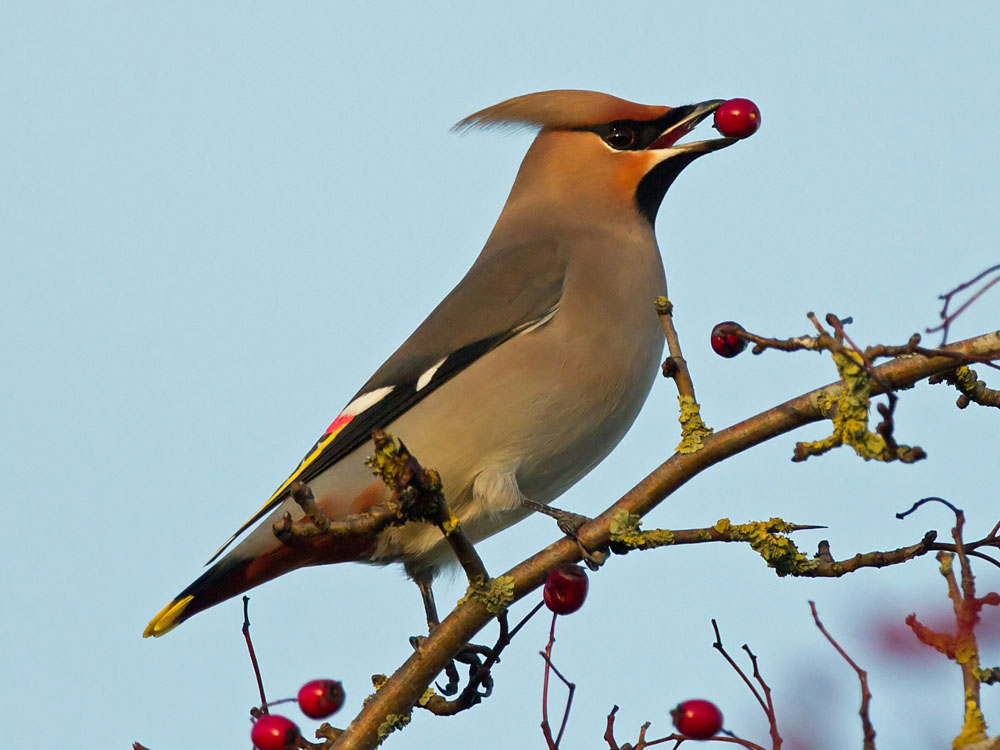
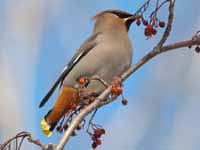
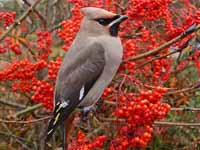
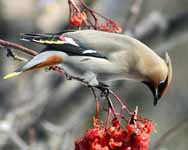
Waxwing,_Cedar Bombycilla cedrorum
Description: The cedar waxwing has a brown mantle with wings and upper-tail mainly grey. It has a brown crest, black mask fringed with white, black throat, light brown neck and breast, yellowish belly. The sqaure-ended tail has a yellow or orange tip. The similar bohemian waxwing is mostly grey. The cedar waxwing is about 15 cm long.
Range: Breeds in southern Canada and winters in southern half of US plus Central America.
Habitat: Open woodlands with access to water. Like to bathe in and drink from shallow creeks.
Diet: Fruit, berries, insects. Yes it does it berries from cedar trees.
Conservation status: Least Concern.
Image by: 1, 3) Dick Daniels - North Carolina 2) Dick - Acadia National Park, Maine 4) Becky_Matsubara - CA Range: Breeds in southern Canada and winters in southern half of US plus Central America.
Habitat: Open woodlands with access to water. Like to bathe in and drink from shallow creeks.
Diet: Fruit, berries, insects. Yes it does it berries from cedar trees.
Conservation status: Least Concern.
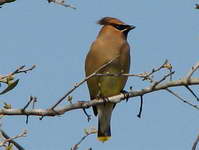
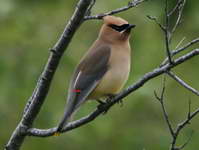
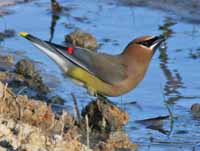
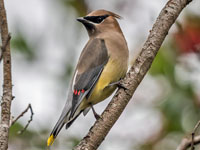
Waxwing,_Japanese Bombycilla japonica
Description: The Japanese waxwing has mainly pinkish-brown plumage. It has a pointed crest, black throat, black eye-stripe, pale yellow center of belly, and a black tail with red tip.
Range: Northeast Asia.
Habitat: Breeds in coniferous forests. Winters where berries are common.
Diet: Fruits, berried, buds, sap. Insects during breeding season.
Conservation status: It is listed as Near Threatened because of worries that logging is affecting its breeding range.
Image by: 1) Jason Buberei 2) Hiyashi Haka 3, 4) Conifer coniferRange: Northeast Asia.
Habitat: Breeds in coniferous forests. Winters where berries are common.
Diet: Fruits, berried, buds, sap. Insects during breeding season.
Conservation status: It is listed as Near Threatened because of worries that logging is affecting its breeding range.
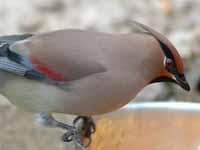
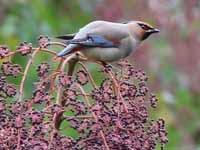
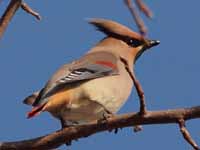
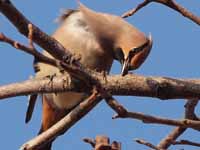
The palmchat is the only species in the genus Dulus and the family Dulidae. It is thought to be related to the waxwings, family Bombycillidae, and is sometimes classified with that group. The name reflects its strong association with palms for feeding, roosting and nesting.
Genus Dulus - 1 species
Palmchat Dulus dominicus
Description: The palmchat has olive-brown upperparts, buff underparts heavily streaked with brown, and a yellow bill. Their rumps and the edges of the primary feathers are yellow-green. The nest is usually constructed in a royal palm. The palmchat is about 20 cm long.
Range:Dominican Republic, Haiti, nearby islands.
Habitat: Moist lowlands, prefering to be near royal palms.
Diet: Fruits, Also insects, especially at breeding time.
Conservation status: Least Concern.
Image by: 1) Luis Alberto 2) Ron Knight - Dominican Republic 3) Pedrito Guzman - Dominican Republic 4) Sandra_Miranda_GonzalezRange:Dominican Republic, Haiti, nearby islands.
Habitat: Moist lowlands, prefering to be near royal palms.
Diet: Fruits, Also insects, especially at breeding time.
Conservation status: Least Concern.
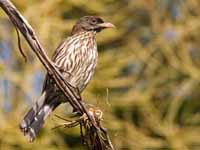
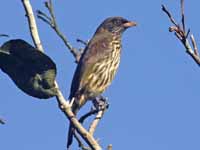
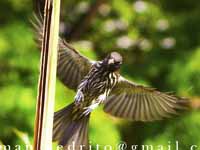
There is only one genus in the Hylocitreidae family. The Hylocitrea closest relatives are probably the waxwings of family Bombycillidae. They families probably split about 20 million years age.
Genus Hylocitrea - 1 species
Hylocitrea also Yellow-flanked Whistler Hylocitrea bonensis
Description: The hylocitrea, also known as the yellow-flanked whistler, has dull green upperparts. It has a grey collar area and grey underparts with yellowish-flanks. It has a greenish-olive head with a faint yellow supercilium. The female has some streaks on the throat. The hylocitrea is up to 15 cm long.
Range: Indonesian island of Sulawesi.
Habitat: Forests above 1000 meters.
Diet: Probably insects.
Conservation status: Least Concern.
Image by: 1) Adolf Meyer Range: Indonesian island of Sulawesi.
Habitat: Forests above 1000 meters.
Diet: Probably insects.
Conservation status: Least Concern.
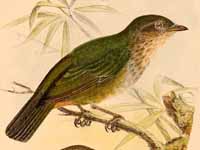
The silky-flycatchers Ptilogonatidae family contains only four species in three genera. They were formerly lumped with waxwings in the family Bombycillidae. The family is named for their silky plumage and their aerial flycatching techniques. Almost all species have small crests. They range in size from 18–25 cm in length and are mostly slender birds. Juveniles birds of both sexes are colored like the female. They eat fruit, berries, and insects. The silky-flycatchers occur mainly in Central America.
Genus Phainopepls - 1 species
Phainopepla Phainopepla nitens
Description: The phainopepla has a crest, long tail, and short a slender bill. The male is glossy black; the female is plain grey. Both sexes have red eyes, but these are more noticeable in the female than the male.
Range: Southwest North America and Central America.
Habitat: Deserts.
Diet: Berries, fruits, insects, vegetables.
Conservation status: Least Concern.
Image by: 1) Alan Vernon 2) Searchnet Media 3) Elaine R Wilson - Arizona 4) New Jersy Birds Range: Southwest North America and Central America.
Habitat: Deserts.
Diet: Berries, fruits, insects, vegetables.
Conservation status: Least Concern.
1, 2) Female 3, 4) Male
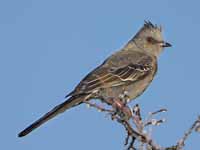
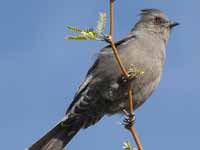
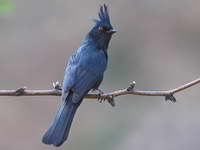
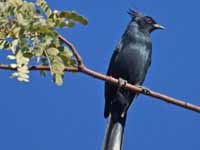
Genus Phainoptila - 1 species
Flycatcher,_Black-and-yellow_Silky- also Black-and-yellow Phainoptila Phainoptila melanoxantha
Description: The male black-and-yellow flycatcher, also known as the black-and-yellow phainoptila, has a black mantle, head, tail, and wings. The rump and flanks are yellow. It has an olive breast and grey belly. The female has olive upperparts including the wings. She has a dark cap. The breast is olive, the flanks yellow, and the nape, throat, plus belly are grey.
Range: Costa Rica to western Panama.
Habitat: Highland forests and adjacent lands.
Diet: Mainly berries; also insects.
Conservation status: Least Concern.
Image by: 1) John_Gerrard_Keulemans 2) Eveha 3) Hans_Zwitzer - Costa RicaRange: Costa Rica to western Panama.
Habitat: Highland forests and adjacent lands.
Diet: Mainly berries; also insects.
Conservation status: Least Concern.
1) Male - top; female - bottom 2) Female 3) Male
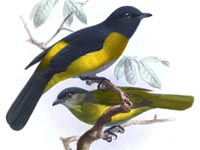
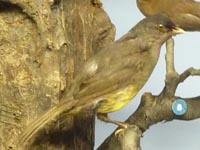
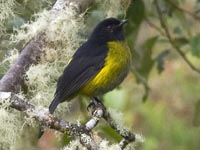
Genus Ptiliogonys
Flycatcher,_Grey_Silky- Ptiliogonys cinereus
Description: The grey silky-flycatcher has brownish-grey to grey upperparts and a long slender grey tail. It has a prominent crest and pale eye-rings. The male has grey underparts with a white belly. The female has a grey upper-breast, brown lower-breast and flanks, plus a white belly. The grey silky-flycatcher is up to 21 cm long.
Range: Guatemala, Mexico.
Habitat: Montane forests and adjacent scrub.
Diet: Berries, fruits, and insects which it catches in flight - leaving form a perch.
Conservation status: Least Concern.
Image by: 1) Ron_Knight - western Mexico 2) Francesco_Veronesi - Mexico 3) Daniel_Beper - MexicoRange: Guatemala, Mexico.
Habitat: Montane forests and adjacent scrub.
Diet: Berries, fruits, and insects which it catches in flight - leaving form a perch.
Conservation status: Least Concern.
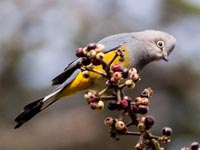
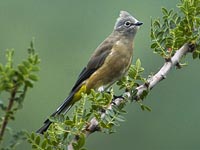
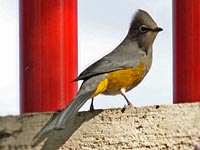
Flycatcher,_Long-tailed_Silky- Ptiliogonys caudatus
Description: The male long-tailed silky-flycatcher has blue-grey upperparts, lower-breast, and upper-belly. It has a yellow crested head with a pale grey forehead. The neck, throat, and lower belly are yellow. It has black pointed tail feathers. The female has a darker grey forehead, an olive body, and shorter plus duller black tail. The long-tailed silky-flycatcher is 20 to 24cm long, with the male larger than the female.
Range: Costa Rica and western Panama.
Habitat: Mountain forests.
Diet: Fruits, berries, insects.
Conservation status: Least Concern.
Image by: 1) Chris_Jimenez 2) David_Rodriguez_Arias - Costa Rica 3) Francesco_Veronesi - PanamaRange: Costa Rica and western Panama.
Habitat: Mountain forests.
Diet: Fruits, berries, insects.
Conservation status: Least Concern.
